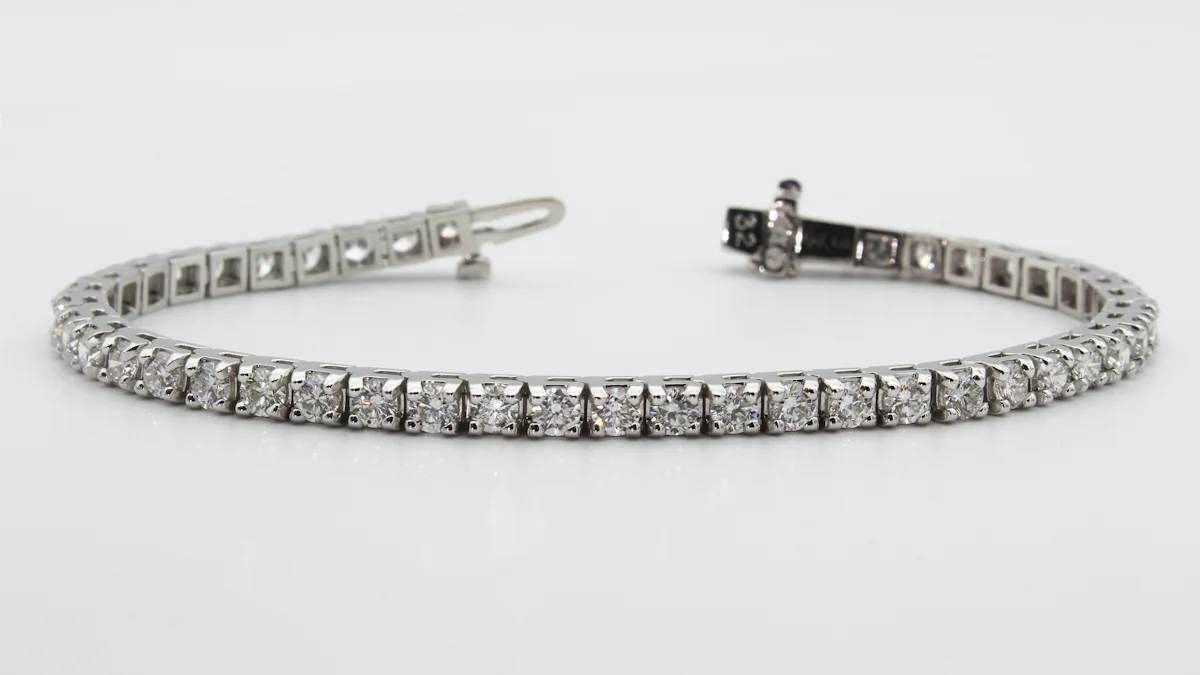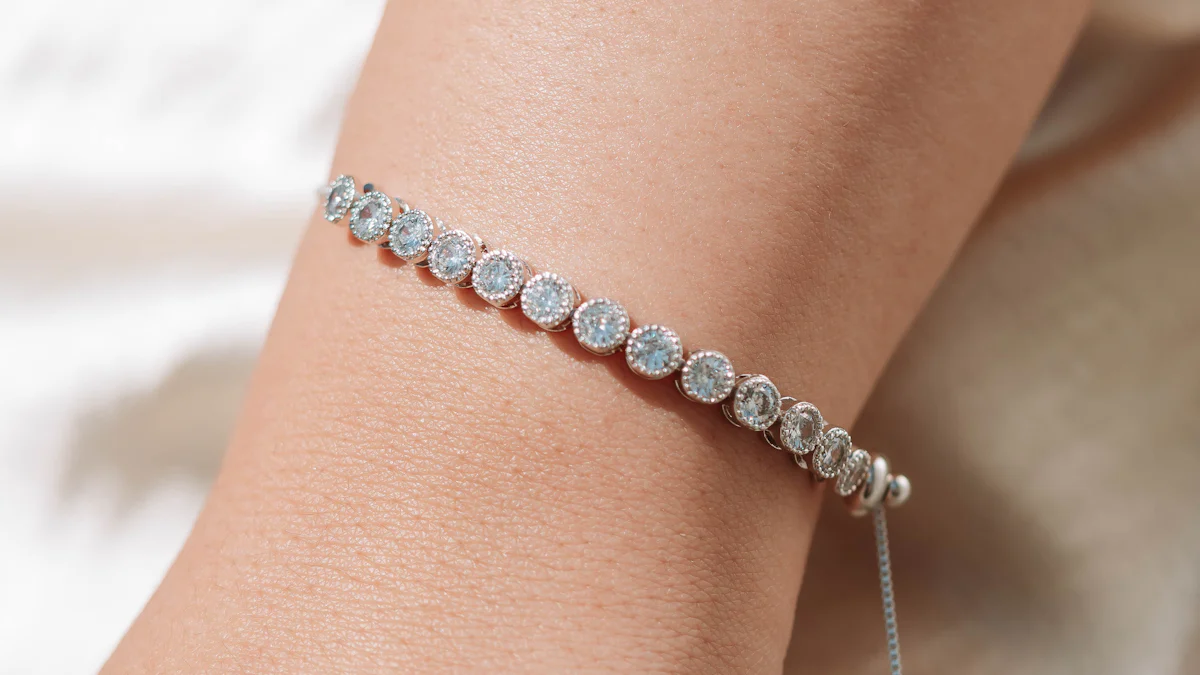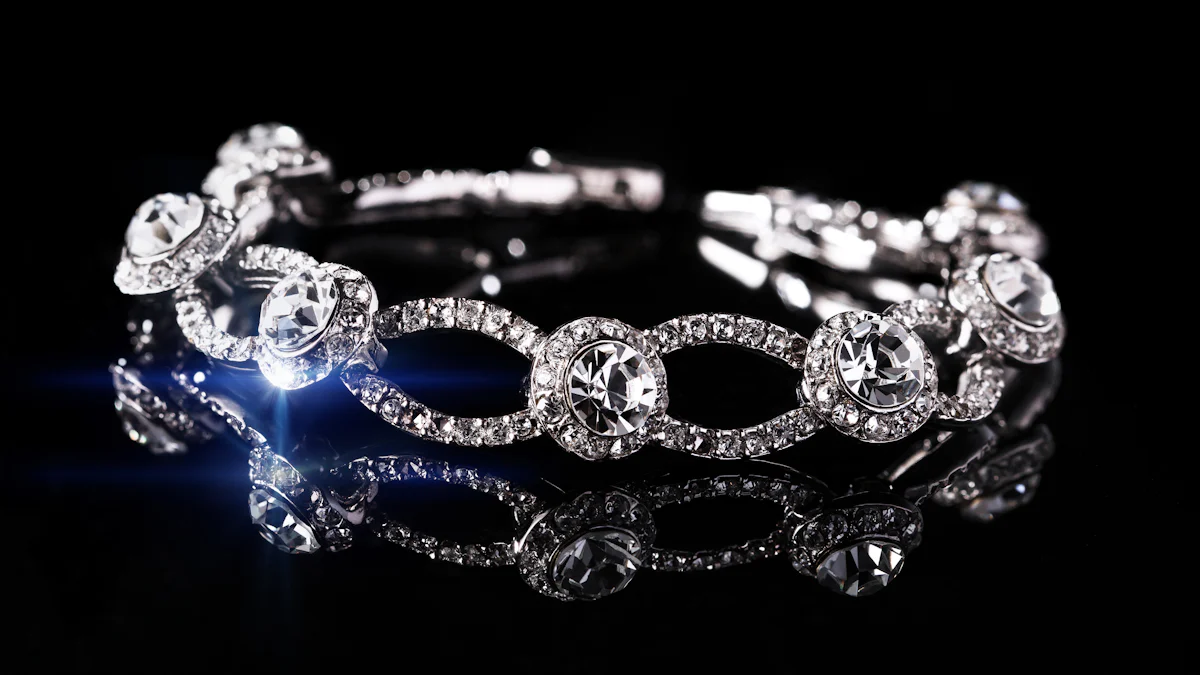Comparing 2 Carat Diamond Bracelet Prices Across Brands

Have you ever wondered why the price of a 2 carat diamond bracelet can vary so much? Several factors drive these differences. The quality of the diamond, determined by the 4Cs—cut, clarity, color, and carat weight—plays a major role. A well-cut diamond sparkles brilliantly but costs more due to the precision involved. Retailers also influence pricing. Luxury brands often charge a premium for their reputation and craftsmanship. Before comparing prices, focus on what matters most to you—whether it’s quality, design, or affordability. Understanding these factors helps you make a confident and informed purchase.
Key Factors Influencing 2 Carat Diamond Bracelet Prices
Diamond Quality and the 4 Cs
How cut, clarity, color, and carat weight affect diamond prices
When it comes to diamond prices, the 4 Cs—cut, clarity, color, and carat weight—are the foundation of value. Each factor plays a unique role in determining how much you’ll pay for a 2 carat diamond bracelet:
- Cut: This is the most critical factor for a diamond’s sparkle. A well-cut diamond reflects light beautifully, making it more desirable and expensive.
- Clarity: Diamonds with fewer inclusions or blemishes are rarer and command higher prices.
- Color: The closer a diamond is to being colorless, the more valuable it becomes.
- Carat Weight: Larger diamonds are priced per carat, meaning the cost increases exponentially with size.
Pricing standards, like the Rapaport Prices List, often emphasize clarity and color. However, cut has the biggest impact on a diamond’s beauty, making it a priority when evaluating diamond prices.
The role of diamond grading in price differences
Diamond grading reports from institutions like GIA or IGI provide a standardized assessment of quality. These reports ensure transparency, helping you understand why one bracelet might cost more than another. A higher grade often means a higher price, but it also guarantees exceptional quality.
Brand Reputation and Perceived Value
Why luxury brands charge a premium
Luxury brands like Cartier, Tiffany & Co., and Bvlgari are synonymous with elegance and exclusivity. Their bracelets often cost more because of their reputation. When you buy from these brands, you’re not just paying for the diamond but also the prestige and craftsmanship associated with their name.
Trust and quality assurance in established brands
Established brands offer more than just a product—they provide peace of mind. Their rigorous quality checks and trusted reputation ensure you’re getting a bracelet that meets the highest standards. This assurance adds to the perceived value, justifying the higher price tag.
Design and Craftsmanship
Custom designs vs. mass-produced options
Custom-designed diamond bracelets are tailored to your preferences, making them unique. However, this exclusivity comes at a premium due to the time and skill involved. Mass-produced options, on the other hand, are more affordable since they’re created in bulk with less individual attention.
The impact of intricate designs on pricing
Intricate designs require exceptional craftsmanship, which increases costs. Simple designs are more budget-friendly, but detailed patterns or artistic elements elevate the bracelet’s value. If you’re looking for something truly special, investing in a finely crafted piece is worth considering.
Additional Features and Materials
Metal type and embellishments
The materials used in a diamond bracelet can dramatically influence its price. When choosing a 2 carat diamond bracelet, you’ll notice that the type of metal plays a significant role in determining its cost. Platinum, for example, is one of the most expensive options due to its durability and rarity. White gold, yellow gold, and rose gold offer more affordable alternatives, but each brings its own unique aesthetic. If you prefer a warm, classic look, yellow gold might be your choice. For a modern and sleek design, white gold or platinum could be ideal.
Embellishments also add to the bracelet’s value. Additional gemstones, such as sapphires, rubies, or emeralds, can elevate the overall price. These gems not only enhance the bracelet’s beauty but also make it more exclusive. Even small design details, like pavé settings or intricate metalwork, require extra craftsmanship, which increases the cost. If you’re looking for a bracelet that stands out, investing in these features can be worth it.
Certifications and authenticity as price factors
Certifications are essential when buying a diamond bracelet. They provide proof of the diamond’s quality and authenticity, giving you confidence in your purchase. Reputable grading institutions like the Gemological Institute of America (GIA) or the International Gemological Institute (IGI) evaluate diamonds based on strict standards. A bracelet with certified diamonds often costs more, but it ensures you’re getting what you pay for.
Authenticity also extends to the bracelet’s materials. High-quality metals and genuine gemstones come with documentation to verify their origin. This transparency not only protects your investment but also adds to the bracelet’s resale value. When comparing prices, always prioritize certified pieces. They may cost more upfront, but they offer long-term peace of mind and value.
Price Comparison of 2 Carat Diamond Bracelets Across Brands

Luxury Brands
Examples of high-end brands and their price ranges
Luxury brands like Cartier, Tiffany & Co., and Harry Winston dominate the high-end market for 2 carat diamond bracelets. These brands often price their bracelets between $15,000 and $50,000 or more, depending on the diamond quality and design. For instance, a bracelet featuring flawless diamonds with intricate settings can easily surpass the $50,000 mark. These brands cater to those seeking exclusivity and timeless elegance.
What justifies the premium pricing in luxury brands
You might wonder why luxury brands charge such high prices. Several factors contribute to this premium:
- Diamonds are meticulously graded for the 4Cs, ensuring only the finest stones are used.
- Expert craftsmanship ensures precise cuts, enhancing brilliance and light reflection.
- Larger carat weights and colorless diamonds (graded D-F) are rare and highly valued.
- Custom designs and unique settings add a personal, luxurious touch.
When you invest in a luxury brand, you’re not just buying a bracelet. You’re purchasing a symbol of prestige, exceptional quality, and unmatched artistry.
Mid-Range Brands
Examples of mid-tier brands offering 2 carat diamond bracelets
Mid-range brands like Blue Nile, Kay Jewelers, and Zales offer a balance between quality and affordability. Their 2 carat diamond bracelets typically range from $5,000 to $15,000. These brands focus on providing high-quality diamonds while keeping prices accessible for a broader audience.
Balancing quality and affordability in this category
Mid-range brands excel at offering value. They use certified diamonds to ensure authenticity and often provide customizable options. While their designs may not match the exclusivity of luxury brands, they still deliver excellent craftsmanship. If you’re looking for a stunning bracelet without overspending, these brands strike the perfect balance between quality and cost.
Online Retailers
Examples of online platforms and their pricing strategies
Online platforms like James Allen and Brilliant Earth have revolutionized the diamond market. Their pricing strategies focus on competitive rates by reducing overhead costs. A 2 carat diamond bracelet from these retailers can range from $4,000 to $12,000, depending on the diamond’s quality and the bracelet’s design. These platforms also offer extensive customization options, allowing you to create a piece that fits your style and budget.
Pros and cons of buying diamond bracelets online
- Cost-Effectiveness: Online retailers often offer lower prices compared to local stores due to reduced operational expenses.
- Extensive Inventory: Platforms like Blue Nile provide a wide selection, making it easier to find the perfect bracelet.
- Convenience: You can shop from home, saving time and effort.
- Detailed Information: High-resolution images and videos help you evaluate diamonds thoroughly.
- Customer Protection: Flexible return policies and secure payment options ensure a safe shopping experience.
However, online shopping has its drawbacks. You can’t physically inspect the bracelet before purchase, and resizing or repairs may require additional effort. Despite these challenges, online retailers remain a popular choice for their affordability and convenience.
Additional Factors That Explain Price Differences
Certifications and Grading Reports
Importance of GIA, IGI, or other certifications
Certifications play a crucial role in determining the price of a diamond bracelet. Trusted organizations like the GIA (Gemological Institute of America) and IGI (International Gemological Institute) provide grading reports that verify a diamond’s authenticity and quality. These reports outline the 4 Cs—cut, clarity, color, and carat weight—helping you understand the bracelet’s true value.
- GIA certifications are highly respected for their impartial grading. Diamonds certified by GIA often cost more because of their strict standards.
- IGI certifications, while more affordable, may have slightly inflated grades. This can make IGI-certified diamonds less expensive but also less trusted by some buyers.
When you choose a bracelet with a GIA certificate, you’re investing in a piece with accurate grading and higher market value. This transparency ensures you know exactly what you’re paying for.
How certifications impact trust and pricing
A certification from a reputable lab like GIA or AGS builds trust. It guarantees the diamond is real and graded accurately. This assurance increases the diamond’s value and justifies its price. Without a certificate, you risk overpaying for a lower-quality diamond. Always prioritize certified pieces to protect your investment and ensure long-term satisfaction.
Customer Service and Warranty
Post-purchase services like resizing and repairs
When buying a diamond bracelet, post-purchase services add significant value. Many brands offer resizing and repair services, ensuring your bracelet fits perfectly and stays in excellent condition. These services save you time and money in the long run. A brand that provides these options shows it values your satisfaction beyond the initial purchase.
Warranty and return policies as added value
Warranties and return policies also influence your buying decision. Most reputable brands offer warranties that cover manufacturing defects, giving you peace of mind. Flexible return policies allow you to exchange or return the bracelet if it doesn’t meet your expectations. Clear communication about these policies ensures you feel confident in your purchase.
Ethical Sourcing and Sustainability
The impact of conflict-free diamonds on pricing
Conflict-free diamonds are ethically sourced, ensuring they don’t fund violence or exploitation. These diamonds often come with a premium price tag, reflecting their responsible origins. By choosing a bracelet with conflict-free diamonds, you’re supporting sustainable practices while owning a luxurious piece.
Sustainability practices and their influence on cost
Sustainability practices, such as using recycled metals or lab-grown diamonds, also affect pricing. While these options may cost slightly more upfront, they appeal to eco-conscious buyers. Investing in a sustainable bracelet not only enhances its value but also aligns with your ethical priorities.
Tips for Finding the Best Value for a 2 Carat Diamond Bracelet

Setting a Realistic Budget
How to determine a budget based on your priorities
Start by deciding what matters most to you. Do you prioritize the brilliance of the diamonds, the exclusivity of the design, or the overall affordability? Knowing your priorities helps you allocate your budget effectively. For instance, if you value exceptional quality, focus on bracelets with high-grade diamonds. If affordability is key, consider mid-range brands or online retailers.
A good rule of thumb is to research average diamond prices for 2 carat diamond bracelets. This gives you a baseline for what to expect. Remember, setting a realistic budget ensures you don’t overspend while still getting a bracelet that meets your expectations.
Comparing Features Beyond Price
Evaluating quality, design, and added services
When comparing bracelets, don’t just focus on the price tag. Look at the quality of the diamonds. The 4Cs—cut, carat weight, color, and clarity—play a huge role in determining the bracelet’s beauty and value. A well-cut diamond sparkles more, while higher clarity and color grades enhance its brilliance.
Also, consider the design. Custom designs or intricate patterns may cost more but offer uniqueness. Added services like warranties, resizing, or repair options can also add value. A reputable jeweler ensures quality and provides guidance, making your purchase more secure.
Tip: Always choose a bracelet that balances quality and design with your budget. A slightly higher price for better craftsmanship or services can be worth it.
Shopping Smart
Researching and comparing brands effectively
Take time to research different brands. Compare their offerings, customer reviews, and certifications. Luxury brands may offer prestige, but mid-range brands or online platforms often provide excellent value. Use online tools to perform a price check and ensure you’re not overpaying.
Leveraging sales, discounts, and promotions
Timing your purchase can save you money. Many retailers offer discounts during holiday sales or special promotions. Sign up for newsletters to stay informed about upcoming deals. Online platforms often have competitive pricing, making them a great option for budget-conscious buyers.
Pro Tip: Combine promotions with your research to maximize savings without compromising on quality.
Understanding the factors that influence the price of a 2 carat diamond bracelet is essential for making a smart purchase. The 4Cs—cut, clarity, color, and carat weight—play a major role in determining value. Luxury brands often charge double the wholesale rates due to their prestige and craftsmanship. Mid-range retailers offer more accessible pricing, while online platforms provide competitive rates by cutting overhead costs.
To find the best value, focus on balancing the 4Cs within your budget. Compare prices, certifications, and vendor options carefully. A well-researched purchase ensures you get a stunning bracelet without overspending.
FAQ
What is the best way to verify the quality of a diamond bracelet?
Always check for certifications from reputable organizations like GIA or IGI. These reports confirm the diamond’s authenticity and grade. Ask the seller for documentation before purchasing. Certified diamonds ensure you’re getting what you pay for.
Are online retailers trustworthy for buying diamond bracelets?
Yes, many online retailers like James Allen and Blue Nile are reliable. Look for platforms with strong customer reviews, secure payment options, and return policies. Always verify certifications and use high-resolution images or videos to inspect the diamonds.
How can I save money on a 2 carat diamond bracelet?
Shop during sales or promotions, especially around holidays. Compare prices across brands and online platforms. Opt for slightly lower grades in clarity or color to reduce costs without compromising beauty. Prioritize value over brand names.
Should I choose lab-grown diamonds over natural ones?
Lab-grown diamonds offer the same brilliance as natural ones but cost 20-40% less. They’re also eco-friendly and conflict-free. If sustainability and affordability matter to you, lab-grown diamonds are an excellent choice.
What’s the most important factor to consider when buying a diamond bracelet?
Focus on the cut. A well-cut diamond maximizes sparkle and beauty, even if other factors like clarity or color are slightly lower. Prioritize certified diamonds and choose a design that matches your style and budget.
See Also
Evaluating Diamond Rings From Leading Gold Band Brands
Assessing 18K Gold Diamond Necklaces From Major Brands
Price Comparison of All Around Diamond Rings

